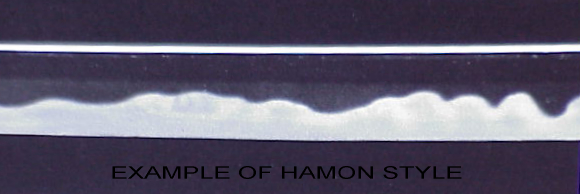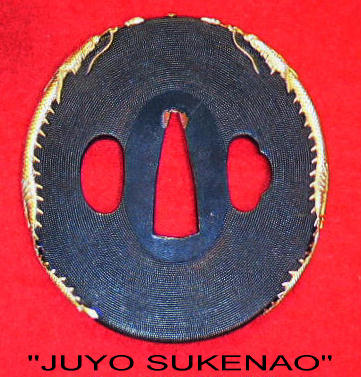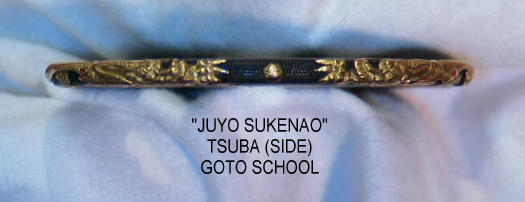Juyo token by the NBTHK
By: David E. J. Pepin
This is one of the most historically significant katana’s, ever created by Sukenao. It has been the property of Daimyos, and in the most prestigious collections since it was produced in 1683. It is considered to be one the most important works of the shinto period. This blade has the distinction and great honor of being illustrated (see actual copy of page below) in Shinto Bengi , which was written by Kamata Natae Sama in 1777! Shinto Bengi , is considered by most experts to be perhaps the most important work of the entire shinto period. For a “shinto” blade to achieve fame during the “shinto period” is extremely rare!
The Relationship of Sukenao & Sukehiro
By: David E. J. Pepin
Sukenao served his apprenticeship in the workshop of Sukehiro I, and soon became the student of Sukehiro II. Sukehiro II, recognizing Sukenao’s extraordinary talent, placed him in the position of foremost student. Sukehiro II had other students: Hiromasa, Suketaka, and Sukemune, to name a few. However, Sukenao was the only one who was able to step forth from the aura of fame surrounding his sensei, and be recognized for his own ability. It was during these years that he presumably married the young sister of Sukehiro II. It is also apparent that he was regarded as more of a son than a son-in-law, thus the theory was formed that he may have been the adopted son of Sukehiro I. Sukenao used the surname of Sukehiro “Tsuda,” indicating a very close bond between them.
Sukehiro II, was summoned to Osaka Castle (see photo) in kanbun 6 (1666) to serve as master swordsmith for the Daimyo Aoyama Inaba-no-Kami, the “HANJI” (chief magistrate or judge) of the castle. It was from this time that his techniques, and the refinement of his work’s rapidly progressed. It was in Enpo that he changed the style of his kanji from kaku (square) to maru (rounded). This is significant because, it is believed that Sukenao joined him at the castle. This is indicated by the the fact that, in Enpo 3rd Sukenao first used the surname “Tsuda”
. It was not seen for the next 7 year’s. I believe he did so to distinguish the blade’s he solely produced from those made with sukehiro, at
osaka castle. It was also at this time that he moved in close proximity to the castle.
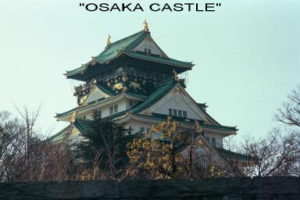
Sukenao produced this blade in 1683, during the reign of the 5 th Shogun “TOKUGAWA TSUNAYOSHI”, ruler of Osaka Castle from 1680 to 1709. TSUNAYOSHI O-SAMA, was known as the “Dog Shogun”, as he was obsessed with the protection of animals, practically dogs! This could have well been the first “Save the animals” campaign in the history of Japan.
After Sukehiro’s death in Tenwa 2 (1682), he began the use of “tsuda” once again. He also changed the the style of his kanji from Kaku (square), to maru (rounded), as did Sukehiro! He worked actively as the head of the Tsuda school, and was the actual successor of “Tsuda Sukehiro”! He was given the name “magodaiyu” (manager or steward).
It is believed that Sukenao died in 1693 at the age of 54 (a respectable age for the period), after a very prolific career.


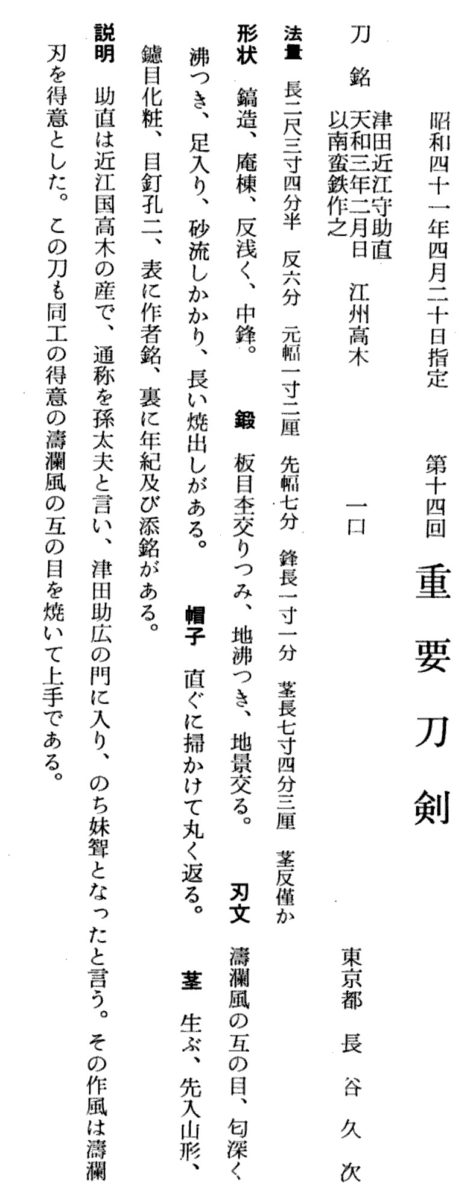
J?y?-t?ken at the 14th j?y? shinsa held on April 20, 1966
katana , mei : Tsuda ?mi no Kami Sukenao – Tenna sannen nigatsu hi G?sh? Takagi, nanban-tetsu o motte kore o tsukuru (??????????????????????????) – “Made by Tsuda ?mi no Kai Sukenao from Takagi in ?mi province in a day in the second month of Tenna three (1683) by using nanban-tetsu ”
T?ky?, Hase Ky?ji (????)
Measurements
nagasa 71.0 cm, sori 1.8 cm, motohaba 3.1 cm, sakihaba 2.1 cm, kissaki-nagasa 3.3 cm, nakago-nagasa 22.5 cm, only very little nakago-sori
Description
Keij? : shinogi-zukuri , iori-mune , shallow sori , ch?-kissaki
Kitae : dense itame that is mixed with mokume and that features ji-nie and chikei
Hamon : t?ran -style gunome in nie-deki with a wide nioiguchi that starts with a long yakidashi and that is mixed with ashi and sunagashi
B?shi : sugu with hakikake and a maru-kaeri
Nakago : ubu , iriyamagata-jiri , kesh?-yasurime , two mekugi-ana , the omote side bears the name of the makes and the ura side bears a date and additional information
Explanation
Sukenao (??) was born in Takagi (??) in ?mi province and his first name was Magoday? (???). He studied with Tsuda Sukehiro (????) and it is said that he later became his brother-in-law by marrying his younger sister. Sukenao focused on a t?ranba and this blade is skillfully hardened in a t?ran -style gunome , which is very typical for the smith as well.
MEI (SIGNATURE)
OMOTE:
“TSUDA OMI-NO-KAMI SUKENAO”
URA:
“TENWA 3rd YEAR 2 nd MONTH A DAY”
“MOTTE NAMBAN TETSU SAKU KORE”
“GOSHU TAKAGI”
NOTE:
NAMBAN TETSU; MADE OF SPECIAL FOREIGN STEEL.
GOSHU TAKAGI; PLACE IT WAS MADE.
PROVINCE: OMI
TITLE: OMI-NO-KAMI
CLAN: N/A
DATE PRODUCED: FEB. 1683 AD.
SCHOOL: TSUDA (OSAKA SHINTO)
SENSEI:
TSUDA SUKEHIRO II GENERATION.
(TEACHER)
IMPORTANCE RATING:
VERY HIGH. “JO – JO” SAKU
(UPPER UPPER CLASS)
KANTEI:
“JUYO TOKEN”
(CERTIFICATION)
BY: * N.B.T.H.K., 14 th. JUYO TOKEN JUDGMENT, SHOWA 41, APRIL 20. 1966 AD
ALSO CERTIFIED IN “SHINTO BENGI” 1777 AD (VERY IMPORTANT)
BLADE TYPE:
KATANA
BLADE STYLE:
SHINOGI ZUKURI
DIMENSION’S
NAGASA (LENGTH):
2 SHAKU, 3 SUN, 4.5 BU.
(APPROX.; 71.1 cm. / 28″)
SORI (CURVATURE):
6 BU.
(APPROX.; 1.8 cm. / .74″)
MOTOHABA (WIDTH):
1 SUN, 2 RIN.
(APPROX. 3.3 cm. / 1.25″)
NAKAGO (TANG):
UBU, 2 ORIGINAL MEKUGIANA, YASURIME – SAKI IRI KESHO YAMAGATA. LENGTH; 7 SUN, 4 BU, 3 RIN.
(22.6 cm. / 10.5″)
(ORIGINAL UNALTERED W / 2 HOLE’S. FILE MARKS ARE CALLED “PRETTY FACE” FASTIDIOUSLY DONE).
MUNE (BACK RIDGE):
IHORI MUNE
(LIKE MOUNTAIN PEAK)
HADA / KITAE (FORGING PATTERN):
ITAME MOKU, JINIE & JIKEI
(WOOD GRAIN, LIKE CHERRY MIXED WITH BURL, LIKE WALNUT. JINIE- BRIGHT VERY SMALL DOT’S & JIKEI- BRIGHT THREAD’S, BOTH OF MARTENSITE CRYSTALS)
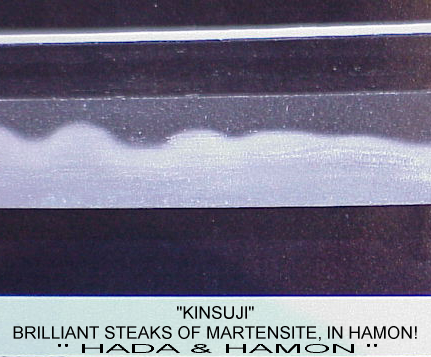
HAMON: TORAN STYLE GONOME, WITH DEEP BRIGHT NIE & NIOI, ASHI, AND SUNAGASHI (BILLOWING HIGH WAVE’S, MIXED WITH BEADS SEPARATED WITH VERTICAL LINES, BRIGHT MARTENSITE DOT’S & LINE’S “VERY DESIRABLE”. SUKENAO WAS FAMOUS FOR THIS TYPE OF TEMPERING.
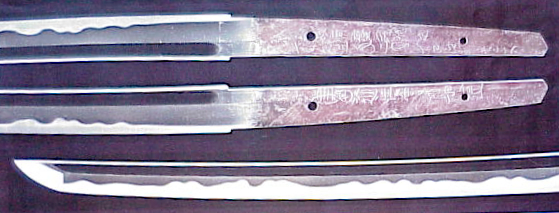
BOSHI:
ROUNDED TURN BACK
(TEMPERING IN POINT)
HORIMONO (ENGRAVING):
HI (HEE)
PERFECTLY CARVED GROVE’S. ANY FORM OF ENGRAVING ON HIS BLADES IS RARE, AND SELDOM SEEN.
KOSHIRAE (FITTINGS): ESTIMATED TO HAVE BEEN MADE IN THE LATE 18 th. CENTURY (1780’s) THEY ARE A MATCHING SOLID SILVER SET! THE TSUBA IS SHAKUDO / NANAKO, AND BEARS THE FAMILY CREST OF THE DAIMYO WHO ONCE OWNED IT. COMMONLY REFERRED TO AS “DAIMYO KOSHIRAE” VERY IMPORTANT!
HABAKI (COLLAR): HEAVY GOLD FOIL
POLISH:
PERFECT “JUYO CLASS”.
EXTREMELY EXPENSIVE, VERY FINEST AVAILABLE.
CONDITION: PRISTINE!
KIZU (FLAWS): NONE
DAMAGE: NONE
NOTATIONS: THIS BLADE HAS BEEN CONSIDERED AS AN “EXTREMELY IMPORTANT MASTERPIECE”, FOR MORE THAN “200 YEAR’S”! IT IS “HISTORICALLY SIGNIFICANT” TO SWORD CONNOISSEURS WORLD WIDE.
PROVENANCE: THE KOSHIRAE BEARS THE “MOKU” MON ( FAMILY CREST ) OF “ITO SAMA” A DAIMYO FROM KYUSHU, DURING THE MIDDLE EDO PERIOD.
* N.B.T.H.K., THE OFFICIAL JAPANESE GOVERNMENT SWORD PRESERVATION AGENCY. TOKYO, JAPAN
This Sword is not available for purchase.
If you wish to purchase a Japanese Sword, please view our Nihonto for sale page or contact us directly via email or by telephone at 1(608) 315-0083 any time. Please include specifics of what you seek, i.e.: Katana, maker, era, price range, etc.
Pictures and content may not be copied without the express permission of samuraisword.com ©



